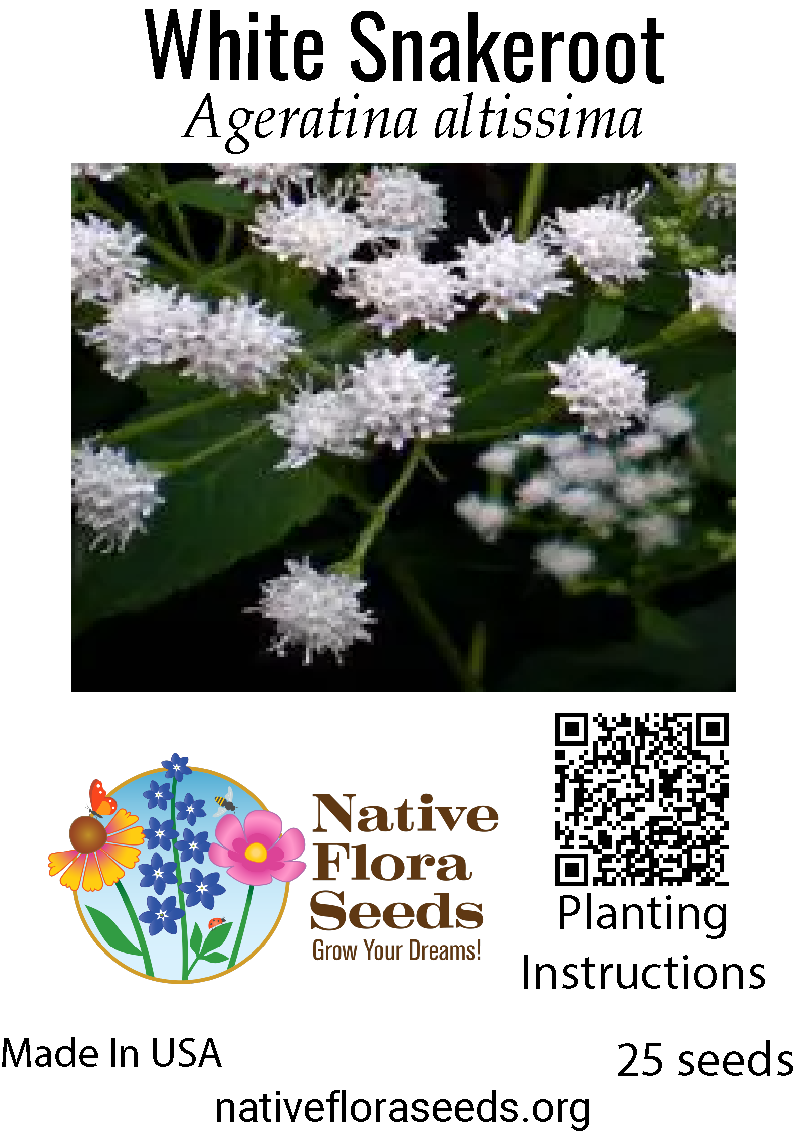Ageratina altissima (White Snakeroot) is a native plant with beautiful white flowers that bloom in late summer and fall. However, it's important to note that it is toxic to humans and animals if ingested. Here's a guide to growing it from seed, keeping that toxicity in mind:
Ageratina altissima (White Snakeroot) Growing Guide
Site Selection
Sunlight: White snakeroot prefers partial shade but can tolerate full sun to full shade. It does best with some protection from the hot afternoon sun.
Soil: It thrives in moist, well-drained soil that is rich in organic matter. It can tolerate a variety of soil types, including clay, loam, and sandy soils, as long as they are not consistently waterlogged.
Location: Choose a location where the plant will have enough space to spread, as it can form colonies over time. Consider its toxicity and avoid planting it where children or livestock might have easy access.
Direct Sowing Outdoors
Fall Planting:
Sow seeds in the fall, a few weeks before the first expected frost. This allows the seeds to naturally stratify over the winter. Preparation:
Scatter the seeds evenly over the soil surface. Lightly press them into the soil or cover them with a very thin layer of soil (no more than 1/4 inch).
Water the seeds gently but thoroughly. Keep the soil consistently moist until germination.
Spring Planting:
Sow seeds in the spring, after the last expected frost.Preparation:
Scatter seeds and lightly press them into the soil, covering with a thin layer of soil (no more than 1/4 inch).
Water gently and keep the soil consistently moist until germination.
Starting Seeds Indoors
Timing: Start seeds indoors 6-8 weeks before the last expected frost in your area.
Preparation: Use seed starting trays or pots filled with a well-draining seed starting mix.
Sowing: Sow seeds about 1/4 inch deep in the seed starting mix.
Stratification: White snakeroot seeds benefit from cold stratification. You can mimic this by placing the seed trays or pots in the refrigerator for 4-6 weeks before sowing.
Germination: Keep the seed starting mix consistently moist and provide adequate light (grow lights or a sunny window). Germination typically occurs within 1-3 weeks.
Transplanting: Once the seedlings have developed a few sets of true leaves, they can be transplanted outdoors. Harden off the seedlings gradually by exposing them to outdoor conditions for increasing periods each day before transplanting.
Seed Scarification
Scarification is not necessary for white snakeroot seeds.
Maintenance Tips
Watering: White snakeroot prefers consistently moist soil. Water regularly, especially during dry periods.
Fertilizing: It does not require heavy fertilization. A light application of a balanced fertilizer in the spring can be beneficial.
Deadheading: Remove seed heads before they mature to prevent self-seeding and control its spread.
Pest and Disease Control: White snakeroot is relatively pest and disease resistant. However, watch out for slugs and aphids.
Caution: Remember that all parts of this plant are toxic if ingested. Handle with care and keep it away from children and livestock.
Invasiveness
White snakeroot can spread aggressively by rhizomes and self-seeding, forming colonies over time. If you want to prevent its spread, remove seed heads before they mature.
Additional Notes
White snakeroot is a valuable plant for providing late-season nectar to pollinators.
It is a native plant that supports local ecosystems.
Important Considerations
Toxicity: White snakeroot contains a toxin called tremetol, which can be harmful to humans and animals if ingested. Be cautious when handling the plant and ensure that it is not accessible to children or livestock.
Milk Sickness: Historically, white snakeroot caused a disease called "milk sickness" in humans who consumed milk from cows that had eaten the plant. This is less of a concern today due to modern agricultural practices.



